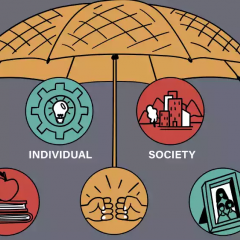This report supplements the Evidence Gap Map and associated report which reviewed the academic literature on protective factors with two new sources of data:
- A review of available information about risk assessment guidelines.
- Interviews with a range of practitioners.
Risk Assessment Frameworks
In order to better assess the risk assessment frameworks on offer we reviewed six frameworks about which there was some publicly available information. We did not have access to the full tools except in one instance.
Most of the guidance we reviewed adopted a structure professional judgment approach (SPJ). SPJ is designed to provide practitioners with guidance but allow them discretion in determining the relative importance of different factors and reach judgements in individual cases.
Of the risk assessment frameworks covered in this review, only the VERA-2R explicitly includes protective factors.
Other tools, such as ERG 22+, stress the importance of practitioners considering protective factors in their assessments, but do not specify independent protective indicators.
Overall, all the risk guidance tools strongly emphasised risk factors which was consistent with the overall balance of academic evidence identified in our earlier report.
The available information overlapped with the previously produced evidence map in some cases (e.g., family support for non-violence) but other factors were either less clearly represented or not represented at all.
Practitioner Perspectives
In addition to reviewing publicly available information on existing forms of risk guidance we interviewed ten practitioners with varied roles in risk assessment and analysed them thematically. We identified three key findings:
- Practitioner conceptualisation of protective factors was nuanced. Practitioners stressed the variance they found in protective factors, how idiosyncratic they could be, and the need to consider protective factors alongside and in interaction with risk factors.
- Practitioners described a range of guidance they used in decision-making, but these were all seen as fitting within the SPJ model. Above all, practitioners emphasised that every case was different and that protection needed to be considered on a case-by-case basis.
- Practitioners identified a range of potential barriers to considering protective factors in their decision-making. They concurred with earlier research which found a relatively limited evidence base for protective factors. They also noted existing social and political biases which resulted in greater emphasis being placed on risk over protection.
Conclusions
Overall, our analysis suggests the following:
- There is a lack of empirical evidence underpinning protective factors in the case of terrorism and a limited understanding of how they work.
- The available research and risk guidance strongly emphasise the consideration of risk factors in assessments.
- Despite this, the SPJ approach as well as practitioner understanding means that consideration of protective factors do play an integral part in how risk assessments are made.
- To move forward, rather than augmenting existing risk-oriented perspectives to incorporate protective factors, there are potential gains from drawing on strength-based approaches as an alternative paradigm to the dominance of risk.
- Taking this broad approach as its starting point, the next phase of our research is to test a strength-based approach to protective factors to understand, empirically, its potential to support work in this area.
Read more
Cole, J., Alison, E., Cole, B., & Alison, L. (2010). Guidance for Identifying People Vulnerable to Recruitment into Violent Extremism. University of Liverpool. https://preventforfeandtraining.org.uk/wp-content/uploads/2017/09/IVP_Guidance_Draft_v0.3_web_version.pdf.
Cook, A. N. (2014). Risk assessment and management of group-based violence [Doctoral dissertation, Simon Fraser University: Department of Psychology]. https://summit.sfu.ca/item/14289
Dean, C. (2014). The Healthy Identity Intervention: The UK’s development of a psychologically informed intervention to address extremist offending. In Silke, A. (ed.) Prisons, Terrorism & Extremism, Critical Issues in Management, Radicalisation and Reform. London: Routledge.
Dickson, S. R., Willis, G. M., & Mather, D. (2018). Protective factors and the good lives model: Combining positive approaches to assessment and treatment. In New Frontiers in Offender Treatment (pp. 43-56). Springer: Cham.
Goodwill, A., & Meloy, J. R. (2019). Visualizing the relationship among indicators for lone actor terrorist attacks: Multidimensional scaling and the TRAP-18. Behavioral sciences & the law, 37(5), 522-539.
Guldimann, A., & Meloy, J. R. (2020). Assessing the threat of lone-actor terrorism: the reliability and validity of the TRAP-18. Forensische Psychiatrie, Psychologie, Kriminologie, 14(2), 158-166.
Guy, L. S., Packer, I. K., & Warnken, W. (2012). Assessing risk of violence using structured professional judgment guidelines. Journal of Forensic Psychology Practice, 12(3), 270-283.
Hart, S. D., Cook, A. N., Pressman, D. E., Strang, S., & Lim, Y. L. (2017). A concurrent evaluation of threat assessment tools for the individual assessment of terrorism. Canadian Network for Research on Terrorism, Security, and Society: Working Paper Series, 17(1), 1-61.
Hassan, G., Brouillette-Alarie, S., Ousman, S., Savard, É. L., Kilinc, D., Madriaza, P., Varela, W., Pickup, D., Danis, E., & the CPN-PREV team. (2021c). A systematic review on the outcomes of tertiary prevention programs in the field of violent radicalization. Canadian Practitioners Network for the Prevention of Radicalization and Extremist Violence. Retrieved from https://cpnprev.ca/systematic-review-3/
Hassan, G., Brouillette-Alarie, S., Ousman, S., Savard, É. L., Kilinc, D., Madriaza, P., Varela, W., Pickup, D., Danis, E., & the CPN-PREV team. (2021c). A systematic review on the outcomes of tertiary prevention programs in the field of violent radicalization. Canadian Practitioners Network for the Prevention of Radicalization and Extremist Violence. Retrieved from https://cpnprev.ca/systematic-review-3/
Herzog-Evans, M. (2018). A comparison of two structured professional judgment tools for violent extremism and their relevance in the French context. European Journal of Probation, 10(1), 3-27.
Lloyd, M. (2019). Extremism Risk Assessment: A Directory. Centre for Research and Evidence on Security Threats. 1-46. https://crestresearch.ac.uk/resources/extremism-risk-assessment-directory/
Lloyd, M., & Dean, C. (2015). The development of structured guidelines for assessing risk in extremist offenders. Journal of Threat Assessment and Management, 2(1), 40.
Loeber, R. E., Farrington, D. P., Stouthamer-Loeber, M. E., & White, H. R. E. (2008). Introduction and key questions. In R. Loeber, D.P. Farrington, M. Southamer-Loeber & H.R.White (Eds.). Violence and serious theft: Development and prediction from childhood to adulthood. Routledge/Taylor & Francis Group (pp3-23).
Lösel, F., Bender, D., Jugl, I., & King, S. (2020). Resilience against political and religious extremism, radicalization, and related violence: A systematic review of studies on protective factors. In D. Weisburd, Savona, E. U., Hasisi, B., & Calderoni, F. (Ed.), Understanding recruitment to organized crime and terrorism (pp. 55-84). Springer. https://doi.org/10.1007/978-3-030-36639-1.
Lösel, F., King, S., Bender, D., & Jugl, I. (2018). Protective Factors Against Extremism and Violent Radicalization: A Systematic Review of Research. International Journal of Developmental Science,
12(1–2), 89–102. https://doi.org/10.3233/DEV-170241
Marsden, S.V. (2017b). Reintegrating radicals: A strengths-based approach to ‘deradicalisation’. In O. Lynch, and J. Argomaniz, (Eds.). (2017). Victims and perpetrators of terrorism: Exploring identities, roles and narratives. Routledge.
Maruna, S., & LeBel, T. P. (2003). Welcome home-examining the re-entry court concept from a strengths-based perspective. W. Criminology Rev., 4, 91.
Meloy, J. R. (2018). The Operational Development and Empirical Testing of the Terrorist Radicalization Assessment Protocol (TRAP–18). Journal of Personality Assessment, 100(5), 483-492. https://doi.org/10.1080/00223891.2018.1481077
Meloy, J. R., Goodwill, A., Clemmow, C., & Gill, P. (2021). Time sequencing the TRAP-18 indicators. Journal of Threat Assessment and Management. Advance online publication.
Pressman, D. E. (2009). Risk assessment decisions for violent political extremism. Public Safety Canada, Government of Canada, Cat. No. PS3-1/2009-2-1EPDF. https://www.publicsafety.gc.ca/cnt/rsrcs/pblctns/2009-02-rdv/2009-02-rdv-eng.pdf
Richards, J. (2018). High risk or low risk: Screening for violent extremists in DDR Programmes. International Peacekeeping, 25(3), 373-393.
Smith, C., & Nolan, M. (2016). Post-sentence continued detention of high-risk terrorist offenders in Australia. Criminal Law Journal, 40(3), 163-179.
Sumpter, C. (2020). Realising violent extremist risk assessments in Indonesia: simplify and collaborate. Journal for Deradicalization, 22, 97‑121.
Wanamaker, K.A. Natalie J. Jones and Shelley L. Brown (2018) Strengths Based Assessments for Use with Forensic Populations: A Critical Review. International Journal of Forensic Mental Health, 17:2, 202-221, DOI: 10.1080/14999013.2018.1451414
Webster, S., Kerr, J., & Tompkins, C. (2017). A process evaluation of the structured risk guidance for extremist offenders. HM Prison and Probation Service, Ministry of Justice Analytical Series.
Copyright Information
As part of CREST’s commitment to open access research, this text is available under a Creative Commons BY-NC-SA 4.0 licence. Please refer to our Copyright page for full details.
IMAGE CREDITS: Copyright ©2024 R. Stevens / CREST (CC BY-SA 4.0)






